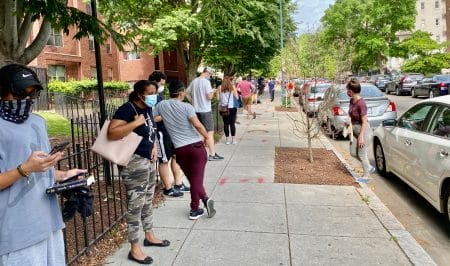Poll Workers Play a Vital Role in Protecting the Right to Vote
Poll workers can make the difference between smooth elections and long lines, frustrated voters, and uncast or uncounted ballots. In 2020, there is a particularly urgent need for new volunteers to step up to staff the polls so that everyone can vote safely and efficiently, and with confidence that their vote will be counted accurately.
Polling locations need healthy, low-risk volunteers
If you and the members of your household are not at high-risk for COVID-19, spending a day working at the polls could be one of the most impactful things you do this year to help protect democracy. You could also help by recruiting more young, healthy people in your community to be poll workers, including high school and college students.
Of course, on Election Day many Sister District volunteers will be diligently calling through voter lists to get out the vote. But while phonebanking is an activity that anyone can do safely, in our current health environment, working at a polling location is not.
In fact, the COVID-19 pandemic has pushed the chronic shortage of poll workers in the United States to crisis proportions. During the 2016 elections, close to one million poll workers were needed to staff over 100,000 polling locations and early voting centers across the United States.
Even before the pandemic, two-thirds of jurisdictions had a difficult time recruiting enough poll workers. And in many areas, there is also an urgent need for more bilingual poll workers and for more poll workers who reflect the communities in which they serve.
Across the country, the majority of poll workers are over 60, precisely the age group at highest risk for COVID-19. Even in the best of times, poll workers are underpaid and under-resourced. During a pandemic without proper training, procedures, and protective equipment, they are being asked to potentially put their health at risk.
In the states that have held primaries since March of this year, thousands of poll workers were understandably too fearful to show up, leading to closed polling places and unacceptably long lines, which sadly increased the infection risk even more for the voters and poll workers who were there in person. Polling place closures also lead to lower turnout and disproportionately impact Black voters. But, it doesn’t have to be this way.
Safe in-person voting options are critical, along with expanded vote-by-mail
While mail voting should be expanded as much as possible during the ongoing pandemic, not every state is willing or able to mail ballots to all eligible voters. Even where mail voting is widely available, options must be preserved for in-person voting for those who need it, including people who need language or disability assistance, homeless people, people who have moved recently, and people with limited access to mail service.
In-person voting is also a necessary safeguard for voters who do not receive their mail ballots on time or experience other obstacles. Many states are trying to implement a large scale vote by mail program for the first time this year, and we’ve already seen major problems in a number of states that have held primary elections since March.

In-person voting during the pandemic can be safe with the proper preparation and implementation. South Korea showed how to do it successfully when it was the first country to hold a national election during the pandemic. Despite being an early hotspot for COVID-19, South Korea had its highest turnout in 28 years for its April election, and no new COVID cases were directly tied to the election.
Election officials in every state should take the necessary steps now to ensure that each jurisdiction has an adequate number of voting locations that are large enough to allow for social distancing, as well as sufficient personal protective equipment and other supplies needed to keep poll workers and voters safe.
If you’re able, sign up to make a difference
Poll workers are hired by local election officials, so the requirements vary from state to state, and even from county to county. Generally, poll workers must be registered to vote in the state–although most states allow older high school students to work elections (with differing eligibility requirements).
Most states require poll workers to complete mandatory pre-election training. In some places, poll workers must have lived in the state for a certain length of time or live in the particular voting district. Additionally, almost all states have distribution requirements regarding the political party affiliation of poll workers.
Compensation for poll workers also varies from state-to-state, and even by local jurisdiction, but the pay is universally low. The hours are often long. Some states allow split shifts, but in many cases poll workers are required to work a 15-hour-plus day from setting up and opening the polls early in the morning until well after the last voter leaves.
But while it may not be the most glamorous or well-paid job, poll workers play a vital role in the democratic process. If you are interested in election reform and looking for concrete ways to make a difference, consider being a poll worker. If you’re able, spending a day working the polls is something tangible and gratifying that you could do to help voters in your community during this incredibly important election year.
To find out more about the process and requirements in your area, contact your local elections office.


